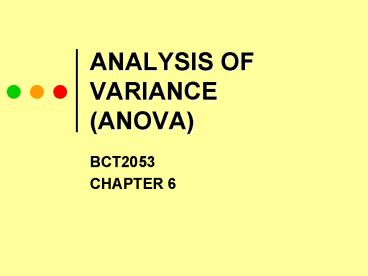ANALYSIS OF VARIANCE ANOVA - PowerPoint PPT Presentation
1 / 19
Title:
ANALYSIS OF VARIANCE ANOVA
Description:
Use the one-way ANOVA technique to determine if there is a significance ... Compute the test statistic. Make the statistical decision. 6.2 One-Way ANOVA ... – PowerPoint PPT presentation
Number of Views:9712
Avg rating:5.0/5.0
Title: ANALYSIS OF VARIANCE ANOVA
1
ANALYSIS OF VARIANCE(ANOVA)
- BCT2053
- CHAPTER 6
2
CONTENT
- 6.1 Analysis of Variance Purpose
- and Procedure
- 6.2 One-Way ANOVA
- 6.3 Two-Way ANOVA
3
OBJECTIVE
- After completing this chapter you should be able
to - Explain the purpose of ANOVA
- Identify the assumptions that underlie the ANOVA
technique - Describe the ANOVA hypothesis testing procedure
- Use the one-way ANOVA technique to determine if
there is a significance difference among three or
more means - Use the two-way ANOVA technique to determine if
there is an effect of interaction between two
factors experiment
4
6.1 Analysis of Variance Purpose and
Procedure
- ANOVA
- the approach that allows us to use sample data to
see if the values of three or more unknown
population means are likely to be different - Also known as factorial experiments
- this name is derived from the fact that in order
to test for statistical significance between
means, we are actually comparing (i.e.,
analyzing) variances. - Example of problems
- A manager want to evaluate the performance of
three (or more) employees to see if any
performance different from others - A marketing executive want to see if theres a
difference in sales productivity in the 5 company
region - A teacher wants to see if theres a difference in
students performance if he use 3 or more
approach to teach.
5
The Procedural Steps for an ANOVA Test
- State the Null and Alternative hypothesis
- Select the level of significance
- Determine the test distribution to use
- Define rejection or critical region
- State the decision rule
- Compute the test statistic
- Make the statistical decision
6
6.2 One-Way ANOVA
- Only one classification factor is considered
Response/ outcome/ dependent variable (samples)
(The level of the factor)
Replicates (1,,j) The object to a given
treatment
7
The resulting input grid of factorial experiment
where, i 1, 2, a is the number of levels
being tested. j 1, 2, is the number of
replicates at each level.
8
Assumptions
- To use the one-way ANOVA test, the following
assumptions - must be true
- The population under study have normal
distribution - The samples are drawn randomly, and each sample
is independent of the other samples. - All the populations from which the samples values
are obtained, have the same unknown population
variance, that is for k number of populations,
9
The Null and Alternative hypothesis
(All population means are equal)
If Ho is true we have k number of normal
populations with
(Not all population means are equal)
If H1 is true we may have 3 normal populations
with
10
The format of a general one-way ANOVA table
T kn
- Reject Ho if
11
Example 1
- The data shows the Maths test score for 4 group
of student with 3 different methods of study.
Test the hypothesis that theres no difference
between the Maths score at significance level
0.05.
12
Example 2
- An experiment was performed to determine whether
the annealing temperature of ductile iron affects
its tensile strength. Five specimens were
annealed at each of four temperatures. The
tensile strength (in ksi) was measured for each
temperature. The results are presented in the
following table. Can you conclude that there are
differences among the mean strengths?
13
6.3 Two-Way ANOVA
- Only two classification factor is considered
14
Assumptions
- The standard two-way ANOVA tests are valid under
the following conditions - The design must be complete
- Observations are taken on every possible
treatment - The design must be balanced
- The number of replicates is the same for each
treatment - The number of replicates per treatment, k must be
at least 2 - Within any treatment, the observations
- are a simple random sample from a normal
population - The sample observations are independent of each
other (the samples are not matched or paired in
any way) - The population variance is the same for all
treatments.
15
The format of a general two-way ANOVA table
Row effect
Column effect
Interaction effect
16
Procedure for Two-Way ANOVA
Ho No interaction between two factors
Yes (Reject Ho)
No (Accept Ho)
Ho No effects from the row factor (the row means
are equal)
Ho No effects from the column factor (the column
means are equal)
17
Example 1
- A chemical engineer is studying the effects of
various reagents and catalyst on the yield of a
certain process. Yield is expressed as a
percentage of a theoretical maximum. 4 runs of
the process were made for each combination of 3
reagents and 4 catalysts. Construct an ANOVA
table and test is there an interaction effect
between reagents and catalyst.
18
Example 2
- A study was done to determine the effects of two
factors on the lather ability of soap. The two
factors were type of water and glycerol. The
outcome measured was the amount of foam produced
in mL. The experiment was repeated 3 times for
each combination of factors. The result are
presented in the following table. Construct an
ANOVA table and test is there an interaction
effect between factors.
19
Summary
- The other name for ANOVA is experimental design.
- ANOVA help researchers to design an experiment
properly and analyzed the data it produces in
correctly way.
Thank You































